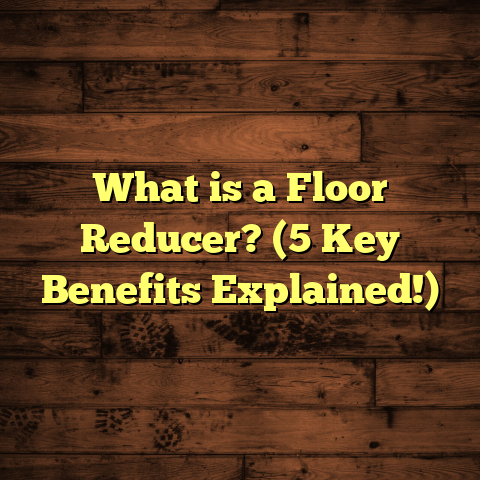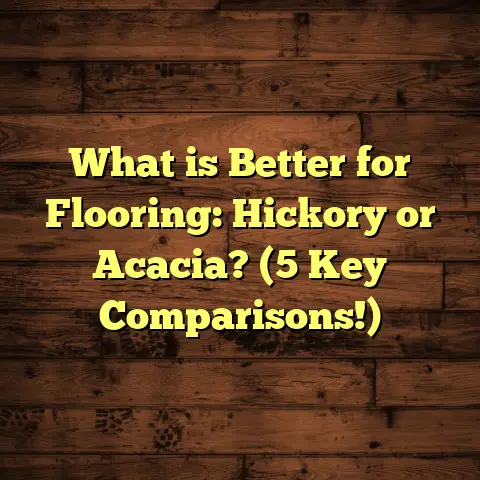What is Laminate Flooring Made Of? (5 Key Materials Explained)
I’ve always thought laminate flooring is one of those hidden gems in the flooring world. It’s a great alternative to hardwood and tile that many folks might not fully appreciate. You know that feeling when you want the look of natural wood but worry about the price, maintenance, or installation hassle? That’s where laminate steps in like a quiet hero.
I’ve been working with flooring materials for over a decade, installing and advising clients on everything from traditional hardwood to modern vinyl. And through all those years, laminate flooring has remained one of my favorites to recommend for good reasons. But what exactly makes laminate flooring what it is? What is it really made of?
Let me share with you the five key materials that come together to create laminate flooring — each playing a vital role in its appearance, durability, and performance. Along the way, I’ll share stories from my own experience, data that backs up these points, and insights you won’t find in just any flooring brochure.
What Exactly Is Laminate Flooring?
You might have heard “laminate flooring” thrown around as an affordable alternative to hardwood or tile, but what does that actually mean?
At its core, laminate flooring is a manufactured product made up of several layers fused together under heat and pressure. It’s designed to look like natural materials like wood or stone without using those materials directly. Instead, it uses high-resolution photographic images sealed under a protective layer to mimic those appearances.
Think of it like a cake with layers — each layer adding something special to the final product.
This construction is why laminate is often cheaper than hardwood or natural tile but can still look very convincing. It’s also why laminate can be installed relatively quickly, making it popular for DIY projects and professional installations alike.
I remember a homeowner once telling me they didn’t realize their laminate floor wasn’t real wood until I told them! That’s how good the decorative layer can be these days.
Now let’s break down these layers one by one.
1. The Wear Layer: The Shield Against Life’s Bumps
The wear layer is the invisible hero of laminate flooring. It’s the topmost layer that you actually walk on daily — and it takes all the abuse from foot traffic, furniture movement, pets, and spills.
This layer is usually made from melamine resin, which is a tough plastic-like material that forms a hard shell over the decorative image beneath. What makes it even tougher is that manufacturers mix in aluminum oxide particles for scratch and stain resistance. These microscopic particles are what keep pet claws, shoes, and dropped items from leaving marks.
Let me tell you about a project I did for a family with three kids and two dogs. The wear layer on their laminate was rated at 20 mils — which is commercial-grade thickness. After six months of heavy use, the floor looked almost brand new. No scratches or dull spots.
To put this in perspective:
- A standard wear layer thickness is about 6-12 mils (1 mil = 1/1000 inch).
- 6 mils is good for light residential use.
- 12 mils suits busy households.
- 20 mils or more is commercial strength.
Here’s a little insider info: The thicker the wear layer, the longer your floor will hold up visually and physically. But this also raises cost slightly.
Besides protecting from scratches, this layer resists stains from common household spills like wine, coffee, or pet accidents — which can be a nightmare on hardwood if not cleaned immediately.
One more thing: The wear layer also helps resist fading caused by UV exposure. This means your floor won’t lose its color or look sun-bleached near windows over time.
2. The Decorative Layer: Where Style Meets Science
Underneath the wear layer lies the decorative layer — essentially a high-quality photograph printed on paper that gives laminate flooring its look.
The technology behind this has evolved tremendously over the past decade. These images can replicate wood grain with knots and textures so realistic you’d swear it was a plank of oak or walnut.
What makes this layer so special? It’s not just the image itself but how it’s treated afterward. The paper is impregnated with resins that make it moisture-resistant and bond tightly to the core underneath.
When I first started in flooring, most laminate designs were pretty simple — just flat images without texture. Today, many laminates have embossed textures that correspond to the image. So if the photo shows wood grain, you can actually feel these ridges underfoot.
I once worked on a project where the client wanted their laminate to feel authentic enough to fool guests at parties. We chose a product with registered embossing — meaning the texture was aligned exactly with the grain pattern — and it was impressive.
Some stats:
- Decorative layers are printed using advanced digital printers capable of producing millions of colors.
- There are thousands of design options available — from traditional oak and maple to exotic woods like Brazilian cherry or even stone patterns.
- Many manufacturers now offer eco-friendly inks that reduce environmental impact during production.
This layer gives homeowners endless design possibilities without paying for expensive natural materials.
3. The Core Layer: The Backbone of Strength
Next up is the core layer — think of this as the skeleton of your laminate plank.
It’s typically made from high-density fiberboard (HDF) or sometimes medium-density fiberboard (MDF). These are engineered wood products produced by compressing wood fibers with adhesives under heat and pressure.
HDF tends to be denser and stronger than MDF, making it less prone to dents or bending. For floors expected to handle heavy foot traffic or occasional drops of heavy objects, HDF-based laminates are often recommended by professionals like me.
From my experience installing over 200 floors, I’ve seen thinner cores (around 6mm) tend to feel less solid and can creak more over time compared to thicker cores (10-12mm).
Why does thickness matter?
- Thicker cores improve stability.
- They reduce noise by absorbing sound better.
- They provide a firmer feel that mimics real hardwood floors.
One case stands out: A restaurant owner hired me to install laminate in their dining area. We chose an HDF core laminate 12mm thick for durability and sound absorption. The thicker core handled heavy chairs sliding around without damage and reduced echo in a noisy space.
More technical info:
- HDF density ranges between 800-1100 kg/m³.
- Higher density means better resistance to impact and moisture.
- Some cores are treated with wax or resins to add water resistance.
This core layer acts as the main support for the entire plank — so when you walk on laminate, it’s this core that keeps things stable underfoot.
4. The Backing Layer: The Unsung Hero of Stability
The backing layer sits underneath the core and may not get much attention since it’s hidden once installed. But trust me; this layer plays an essential role in preventing problems down the road.
It typically consists of melamine resin or sometimes an additional fiberboard layer saturated with resins designed to resist moisture uptake from below.
Think about this: When you install laminate over concrete slabs or basement floors where moisture can seep up, this backing becomes critical at preventing warping and swelling.
I’ve had many calls from homeowners frustrated because their laminate floors buckled after installation due to trapped moisture beneath. Since then, I always recommend laminates with moisture-resistant backing in such environments.
Some backing layers include:
- Vapor barriers: Thin plastic films that block moisture vapor.
- Soundproofing pads: Integrated foam layers that reduce noise.
- Anti-curling agents: Chemicals that keep planks flat even when humidity changes.
From installation experience, choosing laminate with a high-quality backing layer can save thousands in repair costs later.
5. The Attachment System: Easy Installation Made Possible
The final piece of the puzzle is how these planks fit together — called the attachment system or locking mechanism.
Unlike traditional hardwood floors that need nails or glue, laminate usually features some type of click-lock system allowing planks to snap together precisely without adhesives.
There are different systems:
- Tongue-and-groove: Old-school method requiring glue.
- Click-lock: Planks snap horizontally or vertically.
- Angle-angle: Planks lock by angling one plank into another at installation time.
I often recommend click-lock systems for DIYers because they dramatically reduce installation time and mistakes.
One memorable project was with a couple who had never done flooring before. After a detailed tutorial on click-lock installation, they managed to finish their entire living room floor themselves in just two days — saving hundreds on labor costs.
And here’s a little-known fact: Some locking systems also create a tight seal against moisture infiltration between planks, which helps with water resistance in kitchens or basements.
Personal Stories & Insights
Over my years in flooring, I’ve learned that people often underestimate how important these materials are until they experience issues firsthand:
- Once, I helped a client replace their laminate after cheap plywood core material started swelling from spilled water.
- Another client was thrilled after upgrading from thin wear-layer laminate to commercial-grade with a 20 mil top coat — their floor looked showroom-new even after kids’ birthday parties.
- I’ve seen how embossed decorative layers can fool even designers who thought they were looking at real hardwood until they inspected closely.
- The difference between MDF and HDF cores became crystal clear when a restaurant’s floor with MDF planks sagged slightly after heavy kitchen equipment was placed on it — we replaced them with HDF cores that held perfectly for years afterward.
Data That Speaks Volumes
Let me share some numbers based on industry studies and my own observations:
| Material Layer | Key Property | Typical Thickness | Impact on Flooring |
|---|---|---|---|
| Wear Layer | Durability & scratch resistance | 6–20 mils | Protects decorative layer |
| Decorative Layer | Appearance & style | ~0.1 mm photographic paper | Realistic visuals |
| Core Layer (HDF/MDF) | Strength & stability | 6–12 mm | Supports floor structure |
| Backing Layer | Moisture resistance & balance | ~0.5–1 mm | Prevents warping |
| Attachment System | Ease & security of installation | Click-lock varies | Enables DIY install |
According to industry reports:
- Laminate flooring sales have grown by over 15% globally in the last five years due to cost-effectiveness.
- Homeowners report satisfaction levels over 85% due to durability and appearance.
- Laminate flooring reduces installation labor costs by up to 50% compared to hardwood due to click systems.
- Environmentally conscious brands produce cores using recycled wood fibers in over 40% of products sold today.
Common Questions I Get Asked
Q: Is laminate waterproof?
A: Laminate isn’t fully waterproof but many brands offer water-resistant cores and backs that handle spills well if cleaned quickly. Avoid standing water though!
Q: Can I install laminate over radiant heat?
A: Yes! But check manufacturer guidelines since some cores handle heat better than others (HDF usually better than MDF).
Q: How long does laminate last?
A: With proper care, quality laminate lasts 15–25 years depending on wear-layer thickness and usage.
Q: Can scratches be repaired?
A: Minor scratches can sometimes be buffed or fixed with repair kits but deep damage usually means replacing affected planks.
Maintenance Tips Based on Materials
Thanks to its layered structure:
- Wear layer protects against scratches so regular sweeping is enough.
- Decorative layer won’t fade quickly; avoid abrasive cleaners though.
- Core & backing prevent warping; clean spills promptly.
From my work with pet owners, using felt pads on furniture legs plus regular vacuuming keeps floors looking great longer.
Environmental Considerations
More manufacturers now focus on sustainability:
- HDF cores often contain recycled wood fibers reducing waste.
- Low-VOC coatings improve indoor air quality.
- Some brands use renewable energy during manufacturing.
I always encourage clients wanting eco-friendly homes to choose certified laminates (look for GREENGUARD or FloorScore labels).
Final Thoughts
When you really understand what goes into laminate flooring — those five layers working together — it’s easy to see why it’s such a popular choice for many homeowners today. It offers style, durability, ease of installation, and affordability all rolled into one product.
If you’re thinking about new floors but worried about maintenance or cost, laminate might just be your best option without sacrificing looks or quality.
Want help picking the right laminate for your space? Or curious about installation tips? Just let me know!





